CONSUMER BEHAVIOR AND MARKETING MIX FACTORS AFFECTING THE DECISION-MAKING PROCESS OF PURCHASING READY-TO-EAT CHILI PASTE IN MUEANG DISTRICT, LOP BURI PROVINCE
Main Article Content
Abstract
The purpose of this research is to study the marketing mix that affects buyers' decision to purchase ready-to-eat packaged chili paste in Mueang District. Lopburi Province This quantitative research method using a questionnaire which is selected based on convenience. The sample group consisted of people living, studying, or working in Mueang Lopburi District. a total of 400 samples and the data were analyzed for statistics using frequency values (F) percentage (%) mean () and standard deviation (S.D.). The most respondents were female, aged between 31-35 years, bachelor's degree, marital status, occupation, employees of private companies or stores. The monthly income 10,001-15,000 baht. To buy ready-to-use chili paste in packaging 1-2 times a month. Buying 1 bottle at a time in sizes 100-200 grams (1-2 ticks), price 20-30 baht. The most popular to buy chili paste Maepranom brand, by purchasing from modern trade stores such as supermarkets, and department stores to be eaten within their families. The results of the study found that every factor in the marketing mix has a high level of effect. In order to, the price factor (
= 4.27) followed by the product factor (
= 4.23) the distribution location factor (
= 3.89) and the marketing promotion factor (
= 3.56) the sub-factors with the highest average values first in each main factor. The results appear as follows. The product factor is the taste of delicious chili paste (
= 4.56) and the cleanliness of chili paste (
= 4.52), price factor is the price is appropriate for the quality and deliciousness (
= 4.36) distribution factor is available in supermarkets/ department stores (
= 4.34) and the promotion factor marketing was having chili paste to try for free at the point of sale (
= 3.89) respectively.
Article Details

This work is licensed under a Creative Commons Attribution-NonCommercial-NoDerivatives 4.0 International License.
References
กรมทรัพย์สินทางปัญญา. (2555). สถิติการจดทะเบียนเครื่องหมายการค้า 1. เรียกใช้เมื่อ 13 พฤษภาคม 2560 จาก http://www.ipthailand.go/th/ipthailand/index.ph&id=236&Itemid=264
กฤษฎา ศุภวรรธนะกุล. (2549). ลิ้มรสน้ำพริกถ้วยเก่า. เรียกใช้เมื่อ 15 พฤษภาคม 2560 จาก http://www.biothai.net/news/view.php?id=3938
ชาญณรงค์ รอสูงเนิน. (2548). ปัจจัยส่วนประสมการตลาดที่มีผลต่อการตัดสินใจซื้อน้ำพริกแกงของผู้บริโภคในกรุงเทพมหานคร. ใน การศึกษาค้นคว้าแบบอิสระ คณะบริหารธุรกิจมหาบัณฑิต. มหาวิทยาลัยเชียงใหม่.
ธนวัฒน์ คงมอง. (2555). ส่วนประสมการตลาดที่มีผลต่อผู้บริโภคในอำเภอเมืองเชียงใหม่ในการซื้อน้ำพริกพร้อมบริโภค. ใน การศึกษาค้นคว้าแบบอิสระ คณะบริหารธุรกิจมหาบัณฑิต สาขาบริหารธุรกิจ. มหาวิทยาลัยเชียงใหม่.
บงกช พ่วงรักษา. (2551). ปัจจัยส่วนประสมทางการตลาดที่มีผลต่อผู้บริโภคในการซื้อสินค้า OTOP ประเภทน้ำพริกสำเร็จรูปพร้อมบริโภคในบรรจุภัณฑ์. ใน การศึกษาค้นคว้าแบบอิสระ คณะบริหารธุรกิจมหาบัณฑิต สาขาบริหารธุรกิจ. สถาบันเทคโนโลยีพระจอมเกล้าเจ้าคุณทหารลาดกระบัง.
พนิดา สงวนเสรีวานิช. (2550). เปิดตำรับ “น้ำพริกบ้านดอน” แจ๋วปิ-แจ๋วเดือนด้านอาหารสุขภาพไทย. เรียกใช้เมื่อ 31 ธันวาคม 2559 จาก http://maticho.co.th/news_detail.php?id=2217&catid=30.2550
ศศิมา ดำรงสุกิจ. (2550). น้ำพริกสู้โลกาภิวัตน์. เรียกใช้เมื่อ 25 กันยายน 2559 จาก http://www.dailynews.co.th/web/html/popup_news/Defaukt.aspx?Columnid=45149
ศิริวรรณ เสรีรัตน์ และคณะ. (2546). การบริหารการตลาดยุคใหม่. กรุงเทพมหานคร: เพชรจรัสแสงแห่งโลกธุรกิจ.
สิริเกียรติ รัชชุศานติ. (2007). การสุ่มตัวอย่างกรณีไม่ทราบประชากร สถิติทางธุรกิจเพื่อการตัดสินใจร่วมสมัย. (ฉบับที่ 5). เชียงใหม่: มหาวิทยาลัยเชียงใหม่.
หนังสือพิมพ์ผู้จัดการ. (2550). ความสำเร็จน้ำพริกแม่ประนอมยึดแนวคิดทำเองกว่า 47 ปี. เรียกใช้เมื่อ 19 ธันวาคม 2560 จาก http://www.manager.co.th/asp-bon/mrgView.asp?News.ID=95000067


